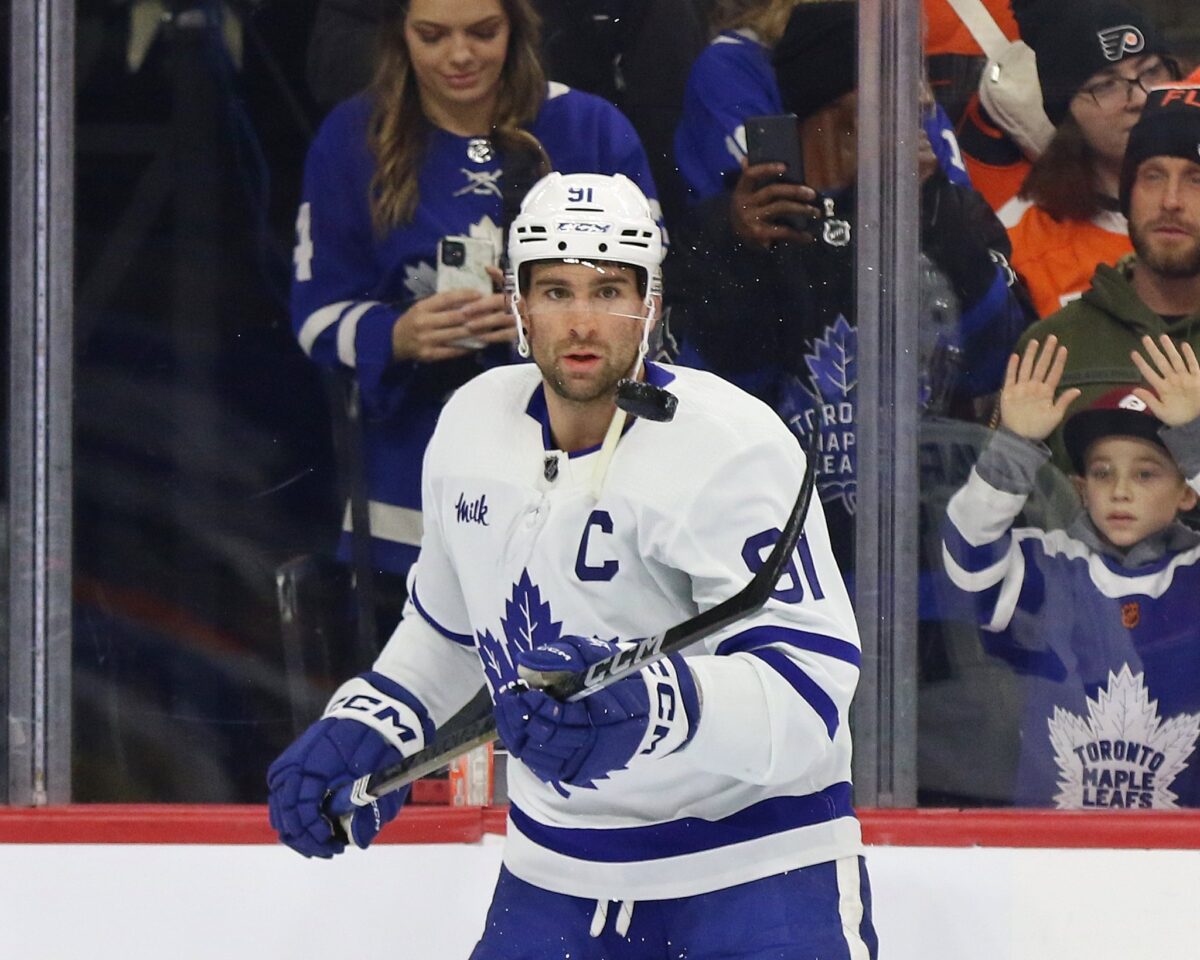The Toronto Maple Leafs have, rightfully, received a lot of slack from fans and foes in the team building department; as of next year, the team will have four players making over 10 million dollars or more against their cap. The “Core Four” — Auston Matthews, Mitch Marner, John Tavares, and William Nylander, will be taking up a combined $46.65 million in 2024-25, partly due to substantial raises for both Matthews and Nylander. Considering that the projected NHL salary cap for next season is $87.7 million, this means that an astounding 53.2 percent of the Maple Leafs’ cap hit will be tied up in four players, leaving their complementary and depth options to a minimum.
Winning teams always have one thing in common: depth scoring ability. There’s always enough money to go around on a true contender for the role players, ones that can use both skill and grit to get things done in the postseason. It’s incredibly difficult to find the right pieces for those roles when four players are taking up over half the cap. In fact, there’s an argument to be made that the Maple Leafs will simply be unable to be a real threat for the Stanley Cup until one or more of the Core Four is off the books.
What Does the Average Player on a Contender Make at Each Position?
I would argue nine teams can realistically compete for the Stanley Cup this season: the Colorado Avalanche, Winnipeg Jets, Boston Bruins, Carolina Hurricanes, Florida Panthers, Vegas Golden Knights, Edmonton Oilers, Vancouver Canucks, and Dallas Stars. With that in mind, let’s take a look at what their players are making by position, starting with the centers.
The first-line centers on each team are making, on average, just north of $9 million annually, with Nathan MacKinnon of the Avalanche making the most at $12.6 million. Second-line centers on these teams are making $4.97 million on average, though this number is a little bottom-skewed on account of Sean Monahan making just $1.985 million in Winnipeg. Third and fourth-line centers are making $2.325 million and $1.375 million, respectively. Keep in mind that the bottom six is most likely where you’ll find young players on their entry-level deals, like Anton Lundell for the Panthers.

Top-line wingers make significantly less than top-line centers, with the average first-line winger on the contenders taking home around $5.5 million annually. Second-liners aren’t far behind, at $4.5 million, though this is where the most deviation from the mean fell. Tyler Seguin of the Stars makes $9.85 million, while Paul Cotter (Golden Knights) and Cole Perfetti (Jets) are on their ELCs. Similarly to the centers, third and fourth-line wingers are making $2.235 million and $1.185 million on the contenders, respectively.
Defense is usually the most balanced in terms of payroll up and down the lineup, and that holds true for contending teams, too. Among these teams, first-pair defensemen make just north of $5.3 million on average, though Dallas’ top-pair blueliner Thomas Harley is still on his ELC. On the contenders, second-pair defensemen are making about $4.125 million, and bottom-pair defensemen are making $2.325 million.
Comparing the Maple Leafs at Each Position
It’s hard to complain about Matthews’ soon-to-be $13.25 million AAV contract being well above the mean value of first-line centers simply because he’s a top-five talent in the NHL, and those players deserve to be compensated as such. The real issue among the Maple Leafs’ is Tavares’ salary. It would be an issue even if he was playing superb hockey — $11 million is an albatross contract for any second-line center in the NHL — but he has been invisible for much of the year, with his point production and underlying statistics well worse than what they were expected to be. The bottom-six center corps is paid fairly, with Max Domi and Pontus Holmberg making a combined $3.8 million, ever-so-slightly north of the combined average of $3.7 million for the other contenders.

For the purposes of this comparison, I’m going to treat both Nylander and Marner as first-line wingers, even though Nylander has lined up on the second line for much of this season. After all, they’re certainly both garnering first-line minutes. With that in mind, the two, this year, are making a combined $17.86 million, well above the combined $10.92 million that the contenders are dealing with. Much like I said with pertinence to Matthews, though, I would argue that the Maple Leafs’ wingers are more talented than the average top-line winger on the mentioned teams. Next year, though, they’ll make a combined $22.4 million — I’m not quite sold that they’re twice as talented as the average top-line winger on a contender.
Related: Grading the Maple Leafs’ Top 7 Right-Wingers
The average second-line winger on the Maple Leafs makes $3.21 million, thanks to Matthew Knies’ entry-level deal. Their third-line wingers are making less than $800,000 each, and their fourth-line wingers are making slightly above $1 million on average. This is the position that Toronto has less wiggle room with as a product of their top-line wingers making much, much more than the average, and it’s a major reason why their depth scoring has struggled all season. They’re simply unable to put as many resources into the bottom six wings as they should.
The Maple Leafs’ top pair on defense makes $6.125 million, less than $700,000 higher than the average contender’s top pair. Many of these teams pair a highly-paid star blueliner (Cale Makar, Adam Fox, Charlie McAvoy) with a more stay-at-home defenseman who gets paid significantly less by proxy of not producing as many points (Devon Toews, Ryan Lindgren, Matt Grzelcyk, respectively), and that holds true with the Maple Leafs, too — Morgan Rielly makes $2.5 million more than his defense partner, T.J. Brodie.

The bottom four on defense is really where the cap crunch from the Core Four hits hard. Their second pair, consisting of Jake McCabe and Simon Benoit, makes a combined $2.775 million, significantly less than the combined $8.25 million on contending teams. Their third pair tells a similar story, with the average third-pair defenseman on the Maple Leafs making $950,000 as opposed to $2.325 million. The players that the Maple Leafs are icing aren’t necessarily bad; in fact, Benoit and Timothy Liljegren have been great. Still, it would be nice for the team to have the ability to get a more prolific, more high-end defenseman in their bottom two pairs than what they have, and the self-inflicted cap crunch by paying four players well over $40 million a year is going to stifle that.
Maple Leafs’ Future Options for the Core Four
Now that Nylander has received a monstrous eight-year contract worth $11.5 million annually, he and Matthews are locked in through the 2027-28 season. Marner and Tavares, on the other hand, have contracts that expire at the end of next season. With that in mind, the Maple Leafs have a few options:
Keeping All Four Around Past 2025
There’s a world in which all four players stick around past the 2024-25 season, though I both would hate to see that come to fruition and think it’s unlikely. Especially with Tavares seemingly hitting a wall in his age-33 season, the only way I see this working out at all is if he takes a massive pay cut. Marner’s contract will likely stay at around the $11 million mark, and I would argue he is worth about that much, even if the public perception of him is a bit skewed in the opposite direction. Like I said, though, this is the unlikeliest of the options they have moving forward — I think GM Brad Treliving knows they can’t bury this much money in this small an amount of players.
Not Re-Signing Tavares
The most likely scenario, and smartest move, would be letting Tavares walk to free agency after the 2024-25 season while re-signing Marner. For all his faults, Marner is an undoubtedly elite winger more than capable of putting up a triple-digit point-total season and is a net-positive on both special teams units as well. Sure, he’s having a bit of a down year — this is the first time in his career since his rookie season that his expected goals share (xGF%) has dipped below 52.5% — but he’s still putting up solid enough numbers, and his track record speaks for itself. As previously mentioned, I’d anticipate his next contract to float around what he’s getting now: just under $11 million.

With that in mind, though, the Maple Leafs would need to let Tavares walk to another team following the 2024-25 season. His age has caught up to him, and he certainly hasn’t been producing like an $11 million player. He’ll be in his age-35 season when his contract expires, and it simply isn’t worth it for the Maple Leafs to spend the money that he’s going to cost, especially not if they want to be able to adequately focus on depth scoring — unequivocally their largest issue.
Trading Marner
The third and final option I see is for the Maple Leafs to trade Marner at or before the 2024-25 trade deadline. I personally think there’s more value to be had in keeping him, but Toronto would certainly be able to acquire a king’s ransom for the star winger. Should they move on from him, I would anticipate the return being similar to the return that the Calgary Flames got from trading Matthew Tkachuk — two high-end pieces, a prospect, and a first-round pick. If Marner doesn’t want to stick around, it’s certainly worth moving him in a trade rather than letting him walk in free agency in 2025.
Maple Leafs Need More Money for Depth
There’s no two ways about it — if the Maple Leafs want to compete for the Stanley Cup, they need to put more money into depth and defense. There’s just no way to adequately ice four lines of competitive players when four players are making over 50 percent of the cap. The Vegas Golden Knights were the first Stanley Cup champion to have a player on their payroll making $10 million or more, and at the very least, the Maple Leafs will have two until 2027-28. It’s just not a recipe for success, despite how talented those individuals may be.
